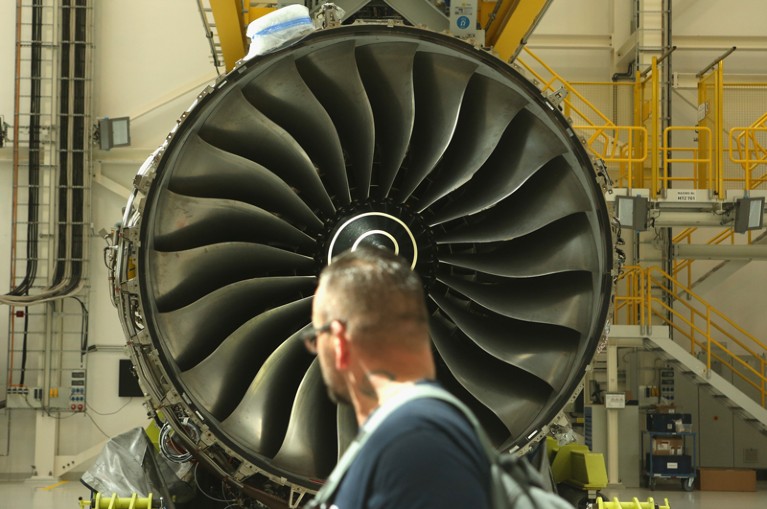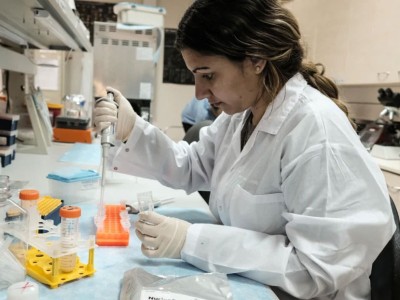
The United Kingdom’s ten biggest spenders on research and development (including Rolls Royce, pictured) spend a combined total of more than £15 billion a year.Credit: Adam Berry/Getty
The UK Office for National Statistics (ONS) is the official keeper of the nation’s data. Every day, many thousands of people rely on the agency for news on the most reliable estimates of everything from trends in COVID-19 mortality to the health of mountain ecosystems.
But lately, the agency itself has been making the news. Last week, it confirmed a big change in the way it assesses how much UK businesses spend on research and development (R&D). Previously, the ONS said that businesses spent £26.9 billion (US$32.4 billion) on R&D in 2020. But as of 22 November, that figure is £43 billion — an increase of almost 60%. The change is not a surprise: it was floated in September, and Nature’s news team reported on it in October. But confirmation that it will be part of national statistics has come fast — perhaps too fast.
Surprise! The UK is spending way more on research than it thought
The change would see the United Kingdom leaping up the World Bank’s 2020 table of R&D spending as a percentage of gross domestic product (GDP) — up from 1.71% in 2019 to 2.4%. This is still lower than the 2020 figures for the United States (3.45%) and Germany (3.14%), but higher than that for France (2.35%) and equal to China’s. By happy coincidence, 2.4% exactly meets the target that the UK government set itself for R&D spending. Thanks to the ONS’s reassessment, this has been achieved five years ahead of schedule.
Researchers’ views on the uprating vary. The Organisation for Economic Co-operation and Development (OECD), the international body that sets standards for R&D measurement, is reviewing the revised estimates.
In the world of R&D (especially in high-income countries), it is businesses, not academic establishments, that spend the most. The ONS’s previous £26.9-billion figure for business R&D came from a survey of some 5,400 companies, taken to represent business R&D more generally. This sample comprises mostly small- and medium- sized enterprises (SMEs), but also includes 400 of the biggest-spending corporations, from pharmaceutical companies such as GSK to banks such as Barclays and the aerospace and defence company Rolls Royce. Between them, the ten companies that finance the most R&D in the country spend more than £15 billion a year.

The Villa Falconieri in Frascati, Italy, was the site of a 1963 expert meeting to agree standards for measuring research and development.Credit: DEA/A. De Gregorio/Universal Images Group North America LLC/DeAgostini/Alamy
One important reason that the ONS made the change was the realization that its survey data (especially those for SMEs) were increasingly out of step with data from the UK tax agency, His Majesty’s Revenue and Customs (HMRC). After comparing its figures with those of tax rebates that HMRC awarded to businesses for R&D spending, the ONS re-calculated total business R&D to be £43 billion for 2020.
There are good reasons for the two agencies to collaborate on their numbers. But there are also good reasons to be cautious and acknowledge the limitations of benchmarking business R&D against tax data. Tax rebates for R&D spending are grounded in the idea that companies are more likely to innovate if they are incentivized to do so. The United Kingdom has been an enthusiastic adopter: it pays out 2.5 times the OECD average as a percentage of GDP. Since the scheme’s introduction, the number of SMEs claiming the rebates has shot up, from fewer than 2,000 in the financial year 2000–01 to nearly 86,000 in 2019–20.
This opens up potential for abuse. Known R&D tax fraud is rising at a worrying rate. Fraud and errors amounted to £469 million in the financial year 2020–21, up from £311 million in 2019–20. Earlier this year, HMRC temporarily suspended payments to companies while it investigated. And in October, the agency arrested 8 people who had submitted more than 100 claims for R&D tax credits. On 17 November, UK finance minister Jeremy Hunt took action, citing fraud as his reason for reducing R&D tax benefits to SMEs.
An attack on the future of science: why UK researchers are striking
Given these concerns, the ONS could have taken more time before finalizing its decision. The agency did consult experts, but a wider and longer consultation would have allowed researchers and other data users to comment on the change. Innovation economists will have a view on the extent to which companies that are claiming back taxes are performing extra R&D. Researchers in forensic accounting can help to benchmark the United Kingdom’s experience with R&D tax fraud against data from other countries. The ONS itself accepts that the United Kingdom is ‘unusual’ in that its R&D spending according to business surveys is smaller than that from tax receipts; it is the other way around in many countries. The OECD’s blessing on the agency’s changes would not have gone amiss, either.
All of this matters. The argument for boosting R&D spending to 2.4% was based on the idea that the United Kingdom is an outlier among the world’s biggest economies. The country performs well on science and innovation indices such as publications, patents and personnel, but it languishes on funding. If the ONS now says that the target has been reached, that diminishes the drive for businesses to push for further R&D spending, especially in an environment in which tough spending decisions are being made. That would be short-sighted at the best of times.
Researchers were instrumental in establishing the first set of rules for R&D spending data, which were agreed at a historic OECD meeting in Frascati, Italy, in 1963 (see the latest version of the Frascati Manual). Research matters as much now as it did then. There is no need to rush the changes. More due diligence will only enhance the ONS’s reputation as a source of trusted data.

 Surprise! The UK is spending way more on research than it thought
Surprise! The UK is spending way more on research than it thought
 An attack on the future of science: why UK researchers are striking
An attack on the future of science: why UK researchers are striking
 Memo to Boris Johnson’s successor: tell the truth, respect evidence and restore trust
Memo to Boris Johnson’s successor: tell the truth, respect evidence and restore trust





